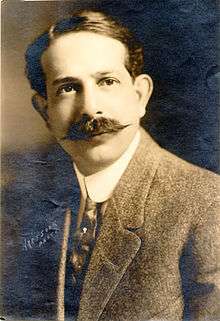G. Albert Lansburgh
Gustave Albert Lansburgh (January 7, 1876 – April 1969) was an American architect largely known for his work on luxury cinemas and theaters. He was the principal architect of theaters on the West Coast from 1900 to 1930.[1]

Life and career
Lansburgh was born in Panama and raised largely in San Francisco. After graduating from that city's Boys High School in 1894, Lansburgh enrolled in the University of California, Berkeley. While a student there, he worked part-time in the offices of prominent San Francisco architect Bernard Maybeck. Upon graduation, he moved to Paris, where in 1901, he was enrolled in the prestigious École des Beaux-Arts, earning a diploma in March 1906.
Lansburgh returned to the Bay Area in May 1906, one month after the region had been devastated by the San Francisco earthquake and subsequent fires. First in partnership with Bernard Julius Joseph for two years, then in his own practice, Lansburgh designed numerous buildings in the recovering city. Among these were four of the seven Carnegie branch libraries for the city [Mission (1915); Sunset (1918); North Beach (1921); and Presidio (1921)][2]:9,11,12 and his first theater, for the San Francisco–based Orpheum Theater Circuit. In his long career thereafter, Lansburgh become known primarily as a theater architect, designing more than 50 of them, many for the Orpheum Circuit and its successor firm, RKO. He continued to design other buildings, including Oakland's Temple Sinai in 1914.[3]
He also collaborated with local architects A. M. Edelman and John C. Austin on the Shrine Auditorium in Los Angeles, and with Arthur Brown Jr. on the War Memorial Opera House (San Francisco). Though many of Lansburgh's best-known works, including El Capitan Theatre in Hollywood, were on the West Coast, his personal favorite was said to have been the Al Hirschfeld Theatre (originally the Martin Beck Theatre) in New York City.
Family
Lansburgh's son was director Larry Lansburgh.[4]
Partial list of theatres designed
- Palace Theatre, Downtown Los Angeles, 1911
- Orpheum Theater (New Orleans), 1918
- Martin Beck Theatre, New York, 1924
- El Capitan Theatre, Hollywood, 1926[5]
- Orpheum Theater, Downtown Los Angeles, 1926
- Shrine Auditorium, Los Angeles, 1926
- Warner Hollywood Theatre, Hollywood, 1928
- Wiltern Theatre, Los Angeles, 1931[5]
See also
References
- Samudio, Jeffrey; Lee, Portia (2001). Images of America: Los Angeles, California (trade paperback). Chicago: Arcadia Publishing. p. 105. ISBN 0-7385-0812-8.
- "Landmark Nomination: Carnegie Branch Libraries of San Francisco" (PDF). San Francisco Public Library. January 2001. Retrieved 11 December 2017.
- Rosenbaum, Fred (2009). Cosmopolitans: A Social and Cultural History of the Jews of the San Francisco Bay Area. University of California Press. p. 89. ISBN 978-0-520-25913-3
- Lawrence M. Lansburgh, by doug Galloway; in Variety; published April 4, 2001; retrieved October 8, 2018
- Lord, Rosemary (2003). Hollywood Then and Now. San Diego: Thunder Bay Press. p. 121. ISBN 1-59223-104-7.